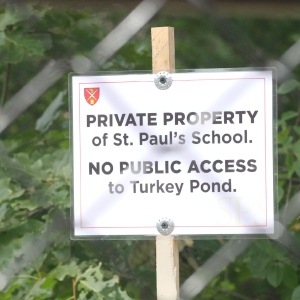NH turkey population avoids decline
| Published: 01-02-2024 3:35 PM |
New England’s wild turkey population seems to have avoided the population declines that are being seen in other parts of the country, and officials are asking for some citizen science help this winter to confirm our status.
“We have not been experiencing the population declines like they have in Midwestern, Southern states. That’s possibly due to more conservative hunting strategies in New England, although nobody is certain,” said Allison Keating, Fish and Game Department’s Turkey Project leader. “There’s a lot of diseases present but disease alone doesn’t seem to be what is driving the population decline.”
The number of wild turkeys in many states have fallen by one-third or more in the past few years – they’re down by more than half in Kansas – after a long period of stable or increasing populations, for reasons that are unclear. New England and most Western states have not been affected.
“I don’t think there’s any one issue that’s causing it. Managers down in those areas are trying to figure it out,” said Andrew Timmins, New Hampshire state wildlife biologist.
Wild turkeys are one of New Hampshire’s great conservation success stories, largely due to the efforts of state biologist Ted Walski, who died late last year at age 76. Turkeys had been wiped out by hunting in the 19th century but came back after 25 birds were released in Walpole in 1975 by Walski, who oversaw their spread to every corner of the state in the following four decades.
Timmins said he thinks the state’s turkey population is probably nearing or has reached its maximum. New Hampshire has two hunting seasons for wild turkeys, one in spring and one in fall.
For a number of years Fish and Game has operated online surveys of turkey populations, which allow people to report sightings of flocks of turkeys. They run a summer brood survey looking for hens with their babies, which are known as poults, to estimate overall reproduction, and a January survey to determine the effect of winter on flock survival. This year’s winter survey has just begun and runs through March.
“Deep snow for prolonged periods can make it difficult for turkeys to travel and find food and water. … “We’ve had several relatively mild winters. That’s popular with turkeys – with snowmobilers, maybe not so much,” said Keating.
Article continues after...
Yesterday's Most Read Articles
 New Concord apartments open in former First Congregational Church
New Concord apartments open in former First Congregational Church
 Georgia’s Northside in Concord transitions into catering and cooking classes
Georgia’s Northside in Concord transitions into catering and cooking classes
 ‘Bittersweet’: The Post on Main Street closes Friday
‘Bittersweet’: The Post on Main Street closes Friday
 Inside EFAs: How school vouchers have fueled an enrollment boom at Christian schools across New Hampshire
Inside EFAs: How school vouchers have fueled an enrollment boom at Christian schools across New Hampshire
 Messy parking around Concord’s bus terminal won’t get less messy any time soon
Messy parking around Concord’s bus terminal won’t get less messy any time soon
 Stefany Shaheen, daughter of New Hampshire senator, launches House bid
Stefany Shaheen, daughter of New Hampshire senator, launches House bid
The biggest issue with the current flocks may have come in warmer times. “Spring and summer were rainy. That may have taken a toll on productivity this summer,” said Keating.
The 2023 Winter Turkey Flock Survey saw a report of 835 flocks, with 15,098 turkeys recorded and an average of 18 turkeys per flock, a slight increase from 2022. That increase, Keating said, was probably the result of more birds going to backyard bird feeders due to a lack of natural food available, since the fall of 2022 was not a good season for acorns and beech nuts, which support turkeys during winter.
Fish and Game is also monitoring two viruses that are present in the wild turkey populations: avian pox and lymphoproliferative disease virus (LPDV). They ask the public to keep an eye out this winter for any turkeys displaying lesions or wart-like protuberances on their head or neck areas and to report these observations through the online survey.
During the winter of 2023, visible lesions which may have been indicative of avian pox or LPDV were reported on 23 turkeys from 11 towns. These finding are similar to the previous year’s survey results and overall reports of symptomatic turkeys remain low.
To report sightings of flocks, go to nhfishgame.com/2024/01/02/report-your-winter-wild-turkey-flock-sightings-today.










 Concord Christian Academy celebrates accomplishment and faith at graduation ceremony
Concord Christian Academy celebrates accomplishment and faith at graduation ceremony Goodwell Foods takes over Rustic Crust private label frozen pizza
Goodwell Foods takes over Rustic Crust private label frozen pizza St. Paul’s School won’t reopen public access to Turkey Pond
St. Paul’s School won’t reopen public access to Turkey Pond Students address worldwide problems through Community Changemaker Challenge
Students address worldwide problems through Community Changemaker Challenge
